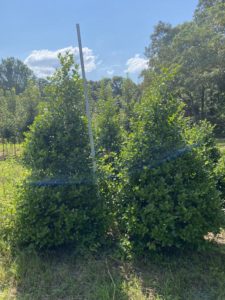At Steve Myers & Son Nursery, we know you aren’t here to twiddle your thumbs. As such, we’ve put together a collection of tips for wintertime landscaping, specifically the plants. Let’s jump right in. Our first tip: use indigenous plants – those native to a particular area – appropriate to your home or landscaping area, whichever applies. Since they’re already suited to a given spot, they need considerably less maintenance. Before committing to any decisions, however, you should first carefully analyze the area you’ll be working in and go from there.
 Don’t Handwave It
Don’t Handwave It
With smaller plants, if you end up making a mistake, it won’t cause you too much trouble down the road – we hope. That’s not so with trees; putting one of those in the wrong spot can give you a serious headache later on, so always be careful with your tree placement. Also consider that, as a rule of thumb, trees are slow growers. By the time they get to maturity you yourself may not even be alive anymore. You aren’t just picking for you; you’re picking for whoever it is will next live in the area in question, and quite possibly one or two generations beyond that.
Leafless But Not Hopeless
Deciduous trees lose their leaves in winter (unless you live in a hot climate, and even then they might). That isn’t always a bad thing: while leaves and flowers are often relied upon to create color and beauty, the bark of a tree is no less beautiful, in its own way. To take advantage of a tree’s winter look, select trees that have visually distinctive bark, which will come to the front during winter. Such trees may end up being smaller than the towering oaks many people might expect to see in a landscape; that can be good or bad, depending on your tastes and the tastes of whoever it is you’re working for (if anyone). Dogwoods and birches can make good winter picks, assuming they can handle the climate you’re looking at.
Berry Good
Berry-bearing plants that keep those berries in winter can add a welcome splash of color to the otherwise dull landscape. Hollies are a favorite for this kind of thing, and crab apples aren’t too uncommon either. If you’re ecologically minded, such plants also provide food for overwintering birds.
Everblue
Despite the name, evergreens aren’t always green, though most are. Since they keep their leaves (or needles, depending on the plant) all throughout the year, they’re important focus points for any winter landscape. If you’re feeling creative, try planting evergreens that aren’t green – blue spruces, for instance. If you’re planting a new bed, we recommend adding at least one evergreen for when winter rolls around.
Perennially Interesting
Perennials that have something to offer in every season are, unsurprisingly, good picks for a landscape. Some ornamental grasses fall into this category, as do hellebores (the latter even bloom in winter, a decidedly unusual trait for a flowering plant). Your local climate heavily influences the options in this regard; if you live in/are landscaping an area that doesn’t have much in the way of four-season perennials, it may be worth considering leaving around plants that have seedheads, such as the black-eyed Susan, until spring to provide some extra interest.

 Don’t Handwave It
Don’t Handwave It